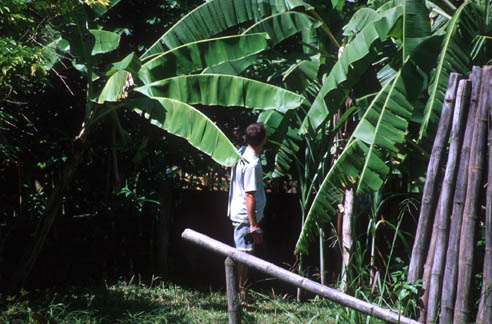 |
|
|
|
|
|
History,
distribution and habitat
The genus Phelsuma is devided into 42 species,and most of those are
devided into several subspecies. Today there are a total of 66 species
of Phelsuma included all subspecies. The first one described was P.cepediana
(Merrem,1820).
There taxonomy is still very confused and new changes are continously
|
|
done.
Even some today unknown species are found allmost
every year. Only during the 90th decade 8 new species was described. The
last recent ones are Phelsuma kely and Phelsuma vanheygeni, and they
were descibed as late as in autum 2004.
Most species inhabit very limited areas, and that makes them very
threatened. The threat comes from the pettrades demand for wildcaught
animales, but mostly from habitat destruction. Most of the species
origin from Madagascar and the isles Comoros, Mauritius, Reunion and
Seychelles. One specie, P.andamanensis comes from the Andaman Island
south of India and two species can be found on the Afrikan mainland.
Most of the species lives in different types of forests and can be found
on trees and other vegetation. A few species lives in dryer
environments.One specie lives on the ground. All species expect from P.uentheri
are moore or less active during the day.
|
|
Appearance and size
Usually the species are devided into three different sizegroups. First
we have the big species, growing to a size between 18-30 cm. The middle
group usually get between 13-18 cm and then we have the smaller species
growing to 10-13 cm.
Characteristic for most species are the brilliant colours. The species
origin from hot and dry environments and the dusk and dawn active. P.guentheri
are some of the few species that lack these colours. The background
colour is often metallic green. Then there are spots and stripes in
different patterns. These spots and stripes are usually red, black, blue,
yellow, orange and brown.
For most people the differens between two equally sized species might
seam hard to see. Still there are allways characteristics that clearly
tells you wich specie in question this is.
As an example P.madagascariensis grandis can be allmost green
with no red spots, and an other individual have red spots allover the
body. Still what is allways there on both these individuals is a red
line from the nose to the eye. This line never continue behind the eye
as it allways does on another subspecie, P.madagascariensis
madagascariensis.
One problem that often occur is that animales from the same specie but
different subspecies are sold as the specie only or by some invented
tradename like Giant Daygecko. Two related animales from the same
specie, but different subspecies usually comes from totaly different
habitats and ofcourse requires different setups to survive. The climat
on Madagascar is extremly different from place to place. Species of the
genus inhabits extremly dry areas , moist and warm lowlandforests to
cold and very humid high altitude rainforests. Some species lives on
2000-2500 meters altitude and these species requires very cold
temperatures during the night.
|
|
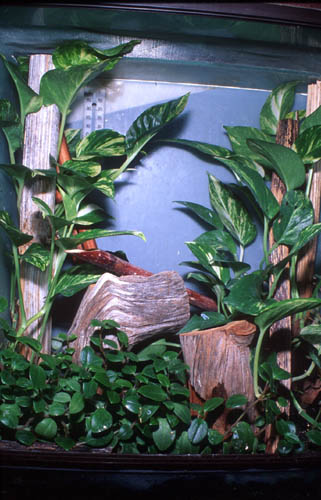
|
The terrarium,lightning and
heat
Since most species are aboreal the terrarium should built high. Suitable
measures for the three different size-groups of Phelsuma are:Bigger
species,50X50X90 cm. Medium sized species,40X40X50 cm and for the small
species,35X35X45 cm.
Since most species comes from moist environments,it is very important
with good vintilation. I recomend ventilation both in top of the
terrarium and on one or both of the sides or front of the terrarium
close to the ground. For most species a relative humidity between 65-80
% is enough.This is easily obtained by misting the enclosure once daily.
If you use pottingsoil or barcmulch as groundmedium and keep it moist
(NOT WET), and decorate with live plants, humidity levels will remain on
a good level.
|
|
One
big advantage with such small animales as Phelsumas is that you can
decorate your terrarium with small and delikate plants like Orchides,
Tillandsias and Bromelides. Bigger terrariuminhabitans would emediately
crush these lovely plants.
One very important detail in every Phelsuma terrarium is some kind of
hollow tubes like Bambustalks or similar. These fulfil several important
tasks. The hole works both as hidingplaces for the animales and
egglayingplaces for the females.
The inside diameter of the Bambu should be slightly bigger then the
specie in question. If you squeeze the Bambu between the top and the
bottom of the terrarium and make a hole in each segment matching the
male and the female both animales have gotten a exellent hidingplace. If
you make one or two holes a bit smaller then the others, the often
smaller female get a place to retreat from the male. These tubes are
also used for basking under the lamps. Daygeckos often prefere to sit in
a vertical posission rather then to sit on a horisontal branch.This
leads us to the terrariums heating and lightning. If we stick to
terrariums of normal size this is easy. To light and heat the terrarium
I only use tubes. Since all Phelsuma species are moore sensitive to heat
then cold this works perfect. The temperature daytime should be between
28-29 deg C and are allowed to drop to 21-22 deg C nighttime.
From November to January you can drop the temperature a few degrees.
This comes naturaly if you light the terrarium 14 hours a day in
summertime and slowly reduce it to 10 hours a day those month. This
works if no other heatsourses are involved. This gives the animales a
restingperioud, and the females normaly stop producing eggs. This is
very important for the females, so they can build up what they have lost
during the breedingseasoon.
The quality of the light is very important.So called daylight or
flurocent tubes are neccesary. There are lots of really good tubes on
the market today, specially developed for reptiles.As a bonus you also
get UVB radiation from this tubes. UVB radiation make the animales able
to produce the neccesary vitamin D3. This vitamin allow the animales to
absorb calium from the food. Keep in mind that most
multipelvitamin pouders contains different amounts of D3. Vitamin D3 is
fatsoluble and if overdosed gives the same symptoms as if the animal
would be short of it.
The tubes should have a colourtemperature close to 6500 deg Kelvin and a
RA of 98. Make sure that the animales are allowed to get really close to
the tubes for basking. Heatsourses like heatpads,hotrocks and heatcables
are NOT for Phelsumas.
|
|
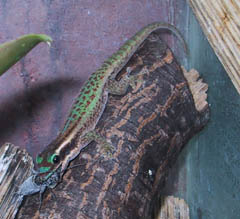
|
Food and Vitamins
Another big advantage with Daygeckos is that they eat both insects and
different fruits. Normally the lizards are feed twize weekly with
insects and once with fruit. During the winter they are only feed twize
a week. Once with insects and once with fruit. The moore you vary
the food with different insects and various fruits the better your
animales will feel.
Do not overfeed because to
fat
|
|
animales
produce less eggs and does not live as long as properly feed animales.
A German firm have during several years examined dead reptiles and among
them lots of Phelsumas . The most common cause of death was fatliver (85
%) caused by to much food or not enough varied food. The most common and
one of the best insects to feed them with are crickets. They are very
nutritious and provide us with various of sizes to feed both small and
big species.As a good complement you can use vaxmoth, grashoppers,
springtails and fruitflies.
With waxmoths you should rather feed the moths then the larva. Even if
the larva can seam to be easily digested they are not. With every
feeding you shold add some kind of multivitamin or mineral pouder. Of
course there are lots of differemt brands on the market today, but if I
can recomend one, I would say Miner-Al. I have used it for many years
with very good results. Among the kind of fruits that Daygeckos like,
Papaya, Mango and Banana are prefered. You can also alter there food
with fruityougurt, honey and different kinds of sweet jam.
Lately there has arrived different kind of so called all in one foods.
As an example you have Zoo-Meds Daygeckofood. None of these are
recomended as only foodsourse because of the very unreliable list of
contents. Regarding the fruit it is allways better offered a bit up in
the terrarium. A very easy way to do this is to use the lids of a bottle,
putted into a clamp used to hold aquarium heaters. Of course vitamins
and minerals should also be added to the fruit.
|
|
Diseases
This is fortunately going to be a quite short episode, because diseases
are not to common with Phelsumas. With this I do not mean diseases
caused by misstreatment and the wrong food. If you do not look at
animales that are wildcaugt and because of that carries lots of
different parasites and often are severely dehydrated, the most common
diseases are related to different kinds of improper care like, lack of
hygiene, lack of ventilation , improper humidity and lack of nutritious
food.
Since most of the species requires humid environments, good hygiene is
required. In a warm and moist environment lots of bacteria and fungus
thrive. If not sufficient ventilation is provided the animales easily
develops respiratory infections and skin infections. If kept to dry they
will get sheddingproblems that for Phelsumas might be fatal. If the old
skin on the feets and toes does not come of the animales lose there
ability to climb, and this condission stresses them to the point that
they might die.
Proper ventilation, humidity and a nutritious and varied food is among
the keys to success. This is extremly important with the fast growing
hatchlings and females producing eggs. Allways add a good multivitamin
with every feeding.
|
|
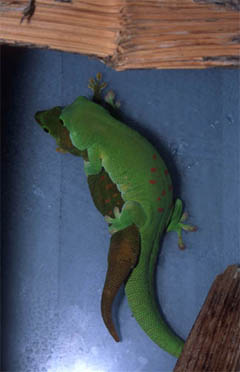
|
Breeding and eggs
Normally most Phelsumas reach maturity at an age of 7-10 month. Care
should be taken to put pairs togerther at to early age. I good rule is
to introduce pairs at two years of age. You will very rarely see the
mating,but traces after it is normally seen. The male usually bite a
firm grip in the cheek during the mating,and sometimes causes small
wounds or bitemarks that are easily seen. The male call on the female by
approaching here with robotlike movements, shaking his head and flicking
with his tounge. If she accept his invitation she stays and let him come
up beside her. Mating normally takes between 5-19 minutes.The male can
be quite rough and cause several wounds on the female during this
process,but this is nothing to worry about.
|
|
These
wound heals in a few weeks. Three to four weeks after mating the female
lays one, but most often two eggs. You can devide Phelsumas into two
categories, egg gluers and non gluers. The species that does not glue
there eggs are the most easy to hatch. The reasoon is ofcourse that you
can move the eggs to an incubator, where you can controle humidity and
temperature.
The eggs are allmost allways layed in the hollow bambustalks or similar.
The female often use the same tube every time she lays eggs. This makes
it easy to look for eggs without disturbing the animales to much. The
eggs are glued together and shoud not be separated. If you try they will
brake. Normaly the female layes eggs once a month during the seasoon. If
in good condition the female can produce up to 20 eggs/year. The egg
gluers are a bit moore difficulte to hatch.
Everything is the same as for the non gluers exept that the eggs are
glued to the surface. If you try to remove them they will break. You
have to incubate them where they are. If they are glued to the glas, put
a plastic cup with holes over the eggs. Inside the cup you place a piece
of paper. Every time you spray the terrarium, also spray on the cup and
allow the paper inside it to get wet. This way you have made a small
incubator in the terrarium. Another reasoon for covering the eggs are
that most proud parents have a hard time to see the difference between
there own offspring and crickets.
|
|
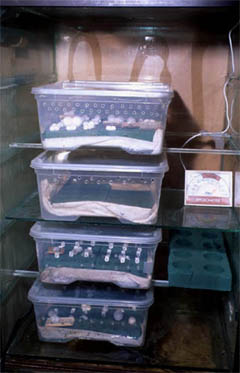
|
Incubating the eggs
Incubating most Phelsuma are quite easy, but differs a bit from how you
incubate other reptile eggs, like Leopardgeckoeggs or other softshelled
eggs. All Phelsuma lay hard shelled eggs, ust like birds. This means
that they do not swell during the incubationperiod as most other
reptile-eggs. Because of that they should not be putten directly on a
moist medium like vermaculite.
Of course you can use vermaculite as medium, but the eggs should rest on
a dry surface. Putting the eggs on filmcan-lids and then on the
vermaculite is an exellent way to do it. This way the eggs are kept on a
dry surface, but still in a moist environment. The eggs can be handled
without risk of damaging the embryos.
They are also quite tollerant to
|
|
different
temperatures and humiditylevels.Suitable is to incubate the eggs at 28
deg C and humidity around 60-80 %. Under these condisions the eggs
normally hatch after 35-90 days, depending on specie.
As with most reptiles the sex of the hatchling have a lot to do with at
wich temperature the eggs have been incubated. Temperatures around 30
deg C will produce mostly males, and temperatures below 25 deg C mostly
females. Unfortunately this does not work on all species. No matter at
what temperature you are incubating the eggs you will allmost only get
males or females from some species. As an example you will very rarely
hatch males from P.guimbeaui subspecies. One way to get around this
problem is to flucturate the incubationtemperature. Keeping the
temperature at 30 deg C daytime and drop it to 24 deg C nighttime will
give you a better ratio of males and females. It does not solve the
problem and give you 50/50,but will increase the number of males.
|
|
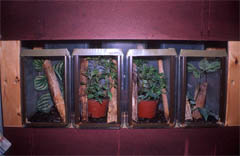
|
Raising the hatchlings
The hatchlings are between 2,2-5,5 cm when they hatch. Caring for them
does not differ much from how you keep the adults, with a few exeptions.
Most species hatchlings are very agressive and are best housed one and
one.
Since most Phelsumas are
very
|
|
productive
you might find yourself needing lots of terrariums. One advantage is
that most hatchlings are very small and do not require big enclosures. I
raise all hatchlings in modified petboxes messuring 15X15X25 cm.
The interior should be simple. One plant for klimbing and humidity, one
tube for basking and hiding and a thin layer of barchmulch as substrate.
Because of there small size the hatchlings easily dehydrate. The
enclosure should be misted twize a day. As food for the young ones
fruiteflies, pinhead crickets, small waxmothlarva springtailes and of
course fruits are suitable. Care should be taken to feed them crickets.
Be sure that all crickets are eaten and not allowed to grow big.
Crickets that are not eaten and allowed to grow could easily eat the
young lizard instead of the lizard eating the cricket as planned. Fruit
should be offered every day for the first month, and after that you feed
them three to four times a week. Normally they reach maturity after 8-12
month.
|
|
Keeping them in pairs or groups
Most Phelsuma species are best kept in pairs. Care should also be taken
to never separate a established pair. Once separated there are no
garanties that they will tolerate the other part after being put
together again. Even a pair that have been the sweetest for many years
might reconsider there relationship after a short separation.
It is possible to keep some species in smaller breeding-groups with one
male and several females. These are P.cepediana, P.guimbeaui
subs, P.klemmeri, P.borbonica subs, P.ornata and P.V-nigra
pasteuri.
Finally I would like to wish all of you who find this genus interesting
the best of luck with your breeding efforts. Keep in mind that all
Phelsumas are listed according to Cites app. B2 exept from P.guentheri
that is A1.This means that they for different reasoons are threatened in
the wild, and all export of Phelsuma species are forbidden from
Madagascar exept for four species where the legal export are heavily
quoted.Bying wildcaught animales are the same as bying problems.
|
|
|
|
|
Copyright
© 2002-2008. Magnus Forsberg Sweden. |

